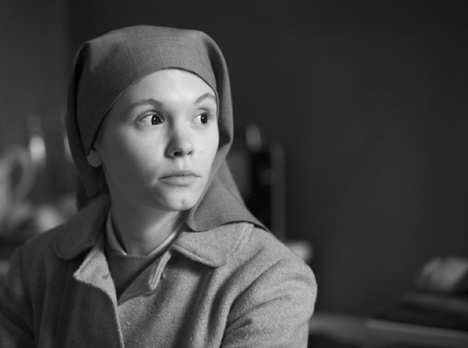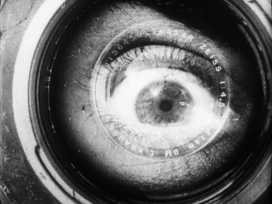
The remaining thousandth
Ord&Bild 5/2022
On the documentary poetry of Jonas Mekas; multi-voiced personalism as literary genre; and the history of the Fens as ecological morality tale.
Pawel Pawlikowski’s film Ida may have won this year’s Oscar for best foreign language film; however, it is far from universally well-received in Poland. While some fear it will resurrect anti-Polish stereotypes, others accuse it of anti-Semitism, writes Filip Mazurczak.
Ida has generated a wave of controversy in Poland and has been attacked both by conservatives and leftists for different reasons. The film tells the story of a young orphaned nun named Anna, who is raised in a convent in post-Stalinist Poland during the early 1960s. Just before taking her final vows, she learns from her superiors that she was born Jewish and her real name is Ida. Her only living relative is Wanda Gruz, a Stalinist judge who sent Polish heroes to the gallows. The two women are given a few days to reconnect. Wanda and Ida investigate Ida’s parents’ death, and learn that the Polish farmer who sheltered her parents ended up killing them. Ida is torn between her Jewish and Catholic identities, between monastic austerity and handsome boys and jazz clubs. She must choose which life to live.

Still of Agata Trzebuchowska in Ida (2013) Photo: © 2014 – Music Box Films. Source:IMDb
The day after Ida won its Oscar for best foreign language film, the Catholic-oriented fronda.pl, one of Poland’s leading rightwing websites, ran with the headline “An Oscar for the controversial and anti-Polish Ida”. Indeed, in recent months, many right-wingers have criticized the film for being anti-Polish. Conservative member of the European Parliament Janusz Wojciechowski said: “This is the first movie of such dimensions and with such class in which there is the Holocaust, but there are no Germans! Jews are not killed by the SS, or some knightly Wehrmacht, but by a wicked, cruel, primitive, filthy Polish peasant lusting after property.” Similarly, Polish political scientist and journalist Michal Szulrzynski expressed concerns on TOK FM radio that western viewers unfamiliar with Polish history will watch Ida and only learn about Poles who killed Jews for property reasons, which is an incomplete image of Polish-Jewish relations.
Meanwhile, the Polish Anti-Defamation League has been circulating an online petition signed by 50,000 people in which it asks the producers of Ida to begin the film with a disclaimer informing the reader that: Poland was occupied by Nazi Germany; its German occupiers exterminated Polish Jews; Poles who hid Jews risked the death penalty, often applied collectively, yet many Poles hid Jews nonetheless; thousands of Poles were executed for helping Jews; the Polish Underground State punished those Poles who harmed Jews; and more Poles have received the Righteous Among the Nations medal (an honour bestowed by Israel’s Yad Vashem Institute for Gentiles who helped Jews for humanitarian reasons) than any other nation. Rightwing Polish publications and politicians have openly supported this petition.
While Poland’s Right accuses Ida of anti-Polonism, its Left accuses it of anti-Semitism. Helena Datner of Warsaw’s Jewish Historical Institute said that “Ida presents a protagonist according to a simple principle: what Poles want to think of a Jewess building real socialism. That she’s a whore and an alcoholic”. Indeed, the film’s Wanda Gruz character is sexually promiscuous and no teetotaler. Meanwhile, feminist Agnieszka Graff of the leftist Krytyka Polityczna has said that Ida is a simplistic story of revenge about a Jewish woman sentencing Poles to death as a vendetta for the death of her relatives. Graff implies that such a narrative feeds into anti-Semitic stereotypes.
In September 1939, Poland was invaded by both Nazi Germany and Soviet Russia. No other country in Europe endured such a brutal occupation. Six million Polish citizens (half Jews, half ethnic Poles, as well as other minorities) were killed. After its inhabitants, Gentile and Jew alike, heroically rose up against the Nazis, Warsaw was razed to the ground, suffering more damage than any other city during World War II, including Hiroshima and Nagasaki.
In the German occupation zone, Germans were allotted 2,613 calories of food a day (well over the 2,000 needed to be healthy), while Poles and Jews were allowed only 669 and 184, respectively, both starvation levels. While Jews were the largest group killed at Auschwitz, non-Jewish Poles come in second place and, up until 1942, the main victims of the concentration camps in occupied Poland were Polish political opponents of Nazi Germany.
Most non-Jewish Poles were themselves struggling to survive an unprecedentedly cruel occupation. Furthermore, the death penalty was applied (often collectively) to Poles who aided Jews: posters reminding Poles of this punishment were all over occupied Poland.
Nonetheless, several hundred thousand Poles hid Jews. Zegota, an organization devoted to aiding Jews, the only of its kind in occupied Europe was formed, and, thanks to money given by the Polish government-in-exile in London, helped finance the survival of 50,000 Jews in hiding. Meanwhile, after the 1943 Warsaw Ghetto Uprising (which was praised in most Polish underground publications), General Wladyslaw Sikorski, Poland’s exiled prime minister, appealed to Poles to aid fugitive Jews and praised the Jewish insurgents’ heroism.
A minority of Poles denounced or killed Jews. Across Poland, gangs of young men called szmalcownicy made a living threatening to denounce fugitive Jews if they failed to pay up. The Polish Blue Police frequently raided Polish houses to seek out Jews in hiding. In the summer of 1941, the Nazis incited Poles to murder Jews in 23 towns in the Lomza region (while individual murders of Jews by Poles occurred across occupied Poland, this region was the only one where pogroms happened on a large scale). The victims in each town ranged from several to several hundred.
However, some stereotypical views of the Holocaust have blown these numbers out of proportion. Yitzhak Shamir, a rightwing Israeli prime minister, said in the 1980s: “Poles suck anti-Semitism with their mothers’ milk”, thus echoing such sentiments, which are undoubtedly harmful to the Poles who risked their lives for their Jewish neighbours, as well as the many more who while not doing so felt great solidarity with the Jews.
As far as the majority of Poles goes, some expressed sympathy and sorrow for the Jews; others, Schadenfreude and said things in the vein of: “Hitler may be a bastard, but at least he solved our Jewish problem.” However, there were cases such as that of the Polish farmer who killed the Jews he was supposed to shelter, and so making a film about such incidents is not anti-Polish. Never is it suggested in the film that the farmer’s behaviour was representative of Polish society. One thing that Ida’s rightwing critics seem to miss is that nuns saved the titular heroine. Indeed, of about 1,600 Polish Catholic convents during World War II, many – almost 1,000 – sheltered Jewish children. In other words, Ida shows both noble and ignoble Polish behaviour.
If Ida is not anti-Polish, is it anti-Jewish? About 300,000 Polish Jews survived the war. Between 40,000 and 60,000 survived thanks to altruistic Poles. Most, however, survived the war by escaping to the USSR, and were then repatriated after the war ended. Many were ideologically brainwashed by the Soviets. Furthermore, many high-ranking officials in the new communist Poland were of Jewish origin. Among them was Helena Wolinska-Brus, the person on whom the character of Wanda Gruz is based. Wolinska-Brus was a Stalinist judge who sentenced many Polish heroes who were both anti-Nazi and anti-communist to death in show trials.
However, it must be said that while Jews were disproportionately represented in Poland’s political elite, they were poorly represented in the Communist Party at the local level. Before World War II, the majority of Polish Jews voted for the Bund (a socialist, although anti-communist, party encouraging Jewish assimilation), followed by the Polish Socialist Party and Zionist parties. Communists received few Jewish votes. In the 1980s, many Poles of Jewish origin – such as Marek Edelman, a hero of the Warsaw Ghetto Uprising, Adam Michnik and Bronislaw Geremek – were high-ranking Solidarity members and advisors to Lech Walesa.
Because Poles of Jewish origin were widely represented in Poland’s ruling elites, the harmful stereotype of Zydokomuna (“Judeo-communism”) developed in Poland, which sparked a wave of anti-Semitic violence in the late 1940s.
While Ida portrays a Jewish character who is a communist, its eponymous protagonist is a Jew who rejects communism, choosing instead the religious life, something that all communists hate, beginning with Marx. Furthermore, Wanda Gruz commits suicide in the film. It is implied she does so out of feelings of guilt. In other words, the film’s alleged Jewish caricature is in fact a morally nuanced affair.
Both the stereotypes of the Polish anti-Semite and of Zydokomuna are hurtful. Helena Wolinska-Brus is not representative of Polish Jewry, and the Lomza area pogroms do not represent the norm in terms of Polish-Jewish wartime relations. However, to say that because Ida features one Polish character who killed Jews and one Jewish character who was a communist (not to mention that the character is based on a real person) criminal is anti-Polish or anti-Jewish, is odd.
Ida is an innocuous film. The Polish Anti-Defamation League and Michal Szuldrzynski are correct to a certain degree: Ida does not provide a full picture of Polish-Jewish relations. However, it must be said that it is not a historical film. Its purpose is not to educate its viewers about the past, but rather, as Pawlikowski has emphasized in interviews, it is a metaphysical story with universal themes of identity, guilt and choice, as well as a nostalgic trip back to early 1960s Poland and its music and fashion styles.
Ida is a textbook example of what in the United States is known as an “arthouse film” – the masses will not flock to it; instead, they will prefer to feast on popcorn in front of Hollywood fodder with little intellectual or aesthetic worth. Ida is a film that will appeal mostly to educated viewers, most of whom already know that Poland was occupied by Germany and that the latter was the prime culprit in the extermination of Europe’s Jews.
If such a viewer’s interest in Polish history is piqued, he will seek out books about Polish history. Inevitably, he will find both dark and bright spots in Polish history, and will learn both about the heroic exploits of Zegota or Polish-Jewish anti-Communists like Edelman, but will also learn about people like Helena Wolinska-Brus and the anti-Jewish violence in the Lomza region.
Published 3 March 2015
Original in English
First published by Visegrad Insight, 24 February 2015
Contributed by Res Publica Nowa © Filip Mazurczak / Visegrad Insight / Eurozine
PDF/PRINTSubscribe to know what’s worth thinking about.

On the documentary poetry of Jonas Mekas; multi-voiced personalism as literary genre; and the history of the Fens as ecological morality tale.

In times of war, art is a source of testimony and helps deal with trauma. Tragic events that are too close in time and space, however, can hinder inspiration and raise moral questions on artistic manipulation.